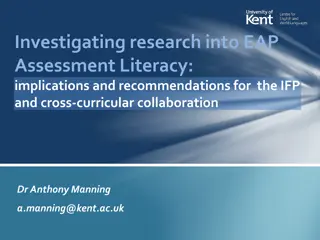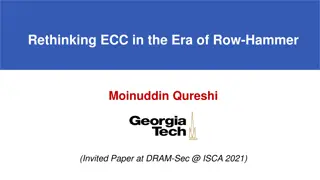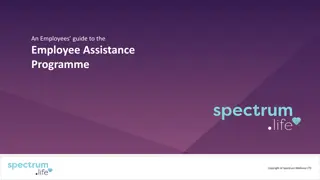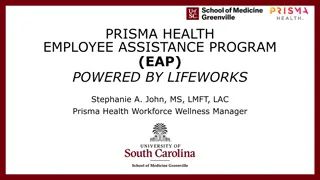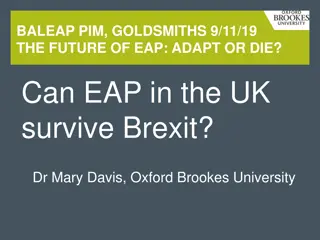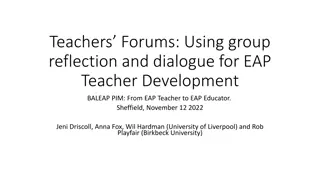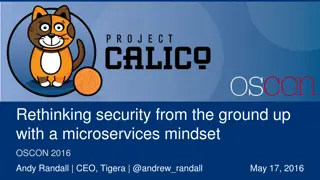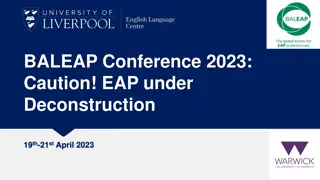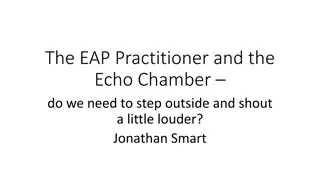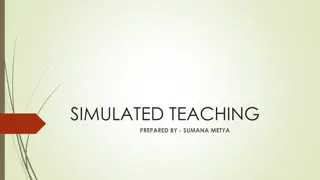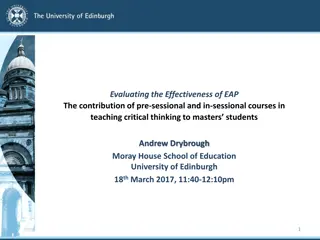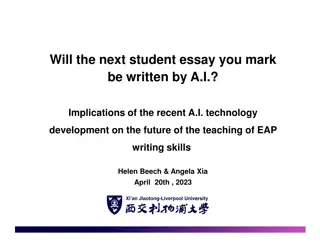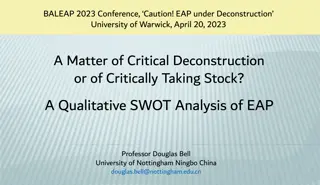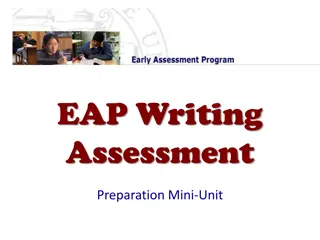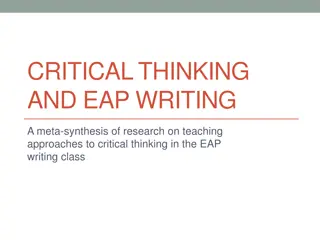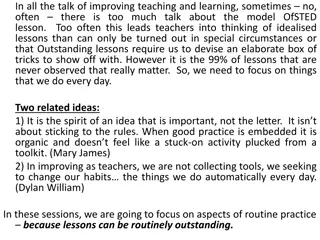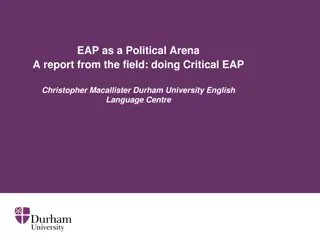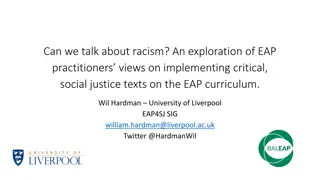Rethinking EAP teaching
This course design book by Olwyn Alexander focuses on rethinking English for Academic Purposes (EAP) teaching in online settings. It explores innovative strategies to enhance the quality of learning experiences. The author provides practical guidance and insights for educators seeking to deliver effective EAP instruction virtually. This resource is invaluable for those looking to adapt their teaching approaches for online environments, ensuring the delivery of impactful and engaging content.
Download Presentation

Please find below an Image/Link to download the presentation.
The content on the website is provided AS IS for your information and personal use only. It may not be sold, licensed, or shared on other websites without obtaining consent from the author.If you encounter any issues during the download, it is possible that the publisher has removed the file from their server.
You are allowed to download the files provided on this website for personal or commercial use, subject to the condition that they are used lawfully. All files are the property of their respective owners.
The content on the website is provided AS IS for your information and personal use only. It may not be sold, licensed, or shared on other websites without obtaining consent from the author.
E N D
Presentation Transcript
Rethinking EAP teaching Course design for quality learning online Olwyn Alexander
The challenge Sudden seismic shift in the way we were expected to deliver PSE IELTS Centres in China closed in March Institutions looked to their English units to help students meet their English condition An opportunity in my case to raise the internal profile of PSE at my institution Ian Jukes on Twitter @ijukes Oct 7
Shifting paradigm for course design To this Moving from this We all use technology for teaching but it is a big leap to use ONLY technology for teaching. Images retrieved 21.8.20 from https://medium.com/@donets.aleksey/online-communication-vs-offline-interaction-what-option-to-choose- 883baf6c28be and https://www.facultyfocus.com/articles/effective-classroom-management/influencing-how-students-discuss-content/
Some more ready than others The Open University L185 EAP Online http://www.open.ac.uk/courses/modules/l185 Coventry University Pre-sessional English Online (2018) https://www.coventry.ac.uk/study-at-coventry/online-learning/pre- sessional-english-online/ BALEAP discussion list hugely supportive & generous community to share experiences and & approaches
Focus of this talk In this talk, I will refer to materials available in advance at http://eap-essentials.com/arguing-from-sources-with-writers-voice/ Brief explanation of course design in my context followed by an overview of theories to support reflection. Not focusing specifically on technical issues and the dynamics of online classrooms. See David Read s posts to the BALEAP discussion list for insights https://designingelt.com/a-few-things-weve-learnt-about-online-delivery- part-1/
Critical evaluation The medium is not the message: the online platform is a means of delivery and not a driver of course design or teaching methodology. Questions for reflection: How well does your course design support learning? Are you teaching something or mainly practising skills? How well does your course design support transfer to degree studies? How well do your teachers understand your course design principles? The intended outcome is to understand ways to evaluate online courses against more general theories of education.
Feedback on course design & delivery Nothing works perfectly first time round as this evaluation shows: Occasionally, the Collaborate [synchronous] slides were too close to the Prep [asynchronous] slides or were set up as answer keys making the teachers feel and appear to be superfluous. Teachers should be used more effectively than as biological answer keys. The design of the course prevented this teacher from teaching effectively We did not explain sufficiently well the underlying principles & how to use the materials
Underlying principles & practice Early experience with Sue Argent & Jenifer Spencer on EAP course for distance learners in 2001-3 EAP Essentials chapter 3 Course Design Core text Access EAP: Frameworks Task based & scenario based and relatively easy to adapt for online delivery Exemplar students as case studies Tells the stories of their academic journeys & challenges they face negotiating the system Images retrieved 12.10.20 from https://www.garneteducation.com/category/english-for-academic-purposes/
Underlying EAP principles for course design English it s about language performance Learning outcomes are the CEFR B2 descriptors required for entry to degrees Academic performance is contextualised within academic content & scholarship Learning outcomes are also graduate attributes acquired by studying a degree, e.g. research-mindedness Purpose it s driven by assessment tasks Simulations of authentic academic genres Students choose concepts to research for ALL coursework
Simulating academic reality Simulate academic assessments as closely as possible, e.g. annotated bibliography & literature review. Mirror academic communication - mostly asynchronous via texts not face-to-face. Use asynchronous communication BlackboardTM Discussion Board & Blog for peer interaction. Image retrieved 21.8.20 from https://www.redballoon.com.au/product/boeing-737-800-flight-simulator---60-minutes/FLE003-M.html
Defining the flipped classroom An educational technique that consists of interactive group learning activities inside the classroom, & direct computer-based individual instruction outside Bishop & Verleger, 2013
Design principles shared at teacher induction Materials driven flipped learning bridging coursebook lessons to online synchronous sessions with voiceover PowerPointTM presentations. Keep it simple don t let technology become the focus of your lessons. Don t waste students time focus on key learning outcomes. In 50 mins there is no time to move through typical activities that a teacher controls: set up tasks, discuss in pairs, share with class. Instead: Concept check (to elicit understanding) teach as new (only if needed) provide metacognitive summaries and links to assessment. Show answers & discuss why these are the answers. Focus on metacognitive aspects to enable transfer of learning to degree studies (Monbec, 2018).
Some of the issues Synchronous sessions were not learning critical Students with tech issues could not access these in real time The main purpose of synchronous sessions was to build a class community of practice to support asynchronous peer-to-peer activities Key issue with teacher identity Many teachers were unhappy with lack of face-to-face teaching. Essential engagement with students was lost in their view Some teachers felt designed out of the course & were uncertain of their role Teacher knowledge about language Teachers new to the programme and some more experienced teachers did not fully understand the concepts they were teaching.
Theories of learning informing reflection Laurillard (2002 and 2012) informs EAP Essentials chapter 3 Designs for learning with & through technology Data-driven informed by empirical studies at the Open University Sarma & Yoquinto (2020) the science transforming how we learn Recently published monograph tracing the history of learning theories Main author is the Head of Open Learning at MIT. Maton (2020) Kirk (2018) Monbec (2018) Legitimation Code Theory, a sociological theory of knowledge Aims to explain how people become experts & how they teach others Specific toolkits semantic gravity & semantic density enable analysis & evaluation of classroom interactions promoting knowledge building
Teaching as collaborative conversation Becoming aware of differences in understanding Working together towards a shared goal Laurillard, 2002 in Alexander et al. 2018 (2nd ed.) p 121-2
Collaborative conversation talk is crucial Uses feedback to change metacognitive understanding Provides feedback on task outcome with metacognitive explanation Shows understanding, by doing a task with metacognitive talk Explains a new concept & illustrates with real world task Laurillard, 2002 in Alexander et al. 2018 (2nd ed.) p 121-2
Other collaborative conversations Feedback on some tasks can be automated Use feedback to repeat tasks or try new ones Collaborate in completing tasks & understanding metacognitive aspects & feedback Peers can share understanding & give feedback Laurillard, 2002 in Alexander et al. 2018 (2nd ed.) p 121-2
The science of learning Human to human education is best but technology can support this (p. xxvi) Theoretical concepts need to be contextualised in real situations (embodied cognition) to be understood (p. 49) Experiential learning in communities of mentors or peers develops embodied cognition (p. 145-6) Effortful retrieval having to work hard to recall concepts helps to fix them in long term memory (p. 128) Effortful retrieval can be promoted through spacing recall, interleaving recall of different subjects, metacognition and regular testing (p.136) Sarma, S. with Yoquinto, L. (2020). Grasp: the science transforming how we learn. London: Robinson.
Issues for flipped learning A human teacher is essential for discussion of & feedback on divergent tasks with no single correct answer, e.g. formative writing tasks. A human teacher is essential to develop metacognitive understanding. A computer can provide correct answers to convergent tasks, e.g. grammar practice activities. Peers can provide learning communities to develop embodied cognition Teachers have to be prepared to cede control of learning to computer- based materials and to students. Many teachers prefer being face-to-face in a classroom where they feel they have more control and the interactions are real .
Legitimation Code Theory With apologies to those who already know and use this theory to inform their practice. To be successful, students have to be able to use meaning- packed, non-context-dependent language and prove that they understand it by unpacking it and grounding it in the real world. i.e. general (conceptual) >> specific (real world case or example) Ingold, R. and O Sullivan, D. (2012) Riding the waves to success. Modern English Teacher Volume 26 Issue 2.
Legitimation Code Theory How much meaning does something contain? Semantic density, SD+ e.g. Plagiarism, Scholarship SD+ Copying the work of others or using your own voice SD- How close to a specific context do you have to be to understand something? Semantic gravity SG+, e.g. Specific task on your PSE in your institution SG+ Metacognitive understanding of task outcome to enable transfer to degree studies SG- Ingold, R. and O Sullivan, D. (2012) Riding the waves to success. Modern English Teacher Volume 26 Issue 2.
Making semantic waves Generalises concepts Builds metacognition Contextualises describes examples and cases, enables embodied cognition Retrieved from Making semantic waves 2013 https://doi.org/10.1016/j.linged.2012.11.005
Semantic wave analysis of a lesson Materials for this lesson can be found here https://eap- essentials.com/arguing-from-sources-with-writers-voice/ The most powerful and sustainable form of immunization against plagiarism is the development of an academic writer s voice (Argent, 2012). Rather than dwelling on the term plagiarism, it is more fruitful to consider the opposite side of the coin, scholarship. Access EAP: Frameworks, Unit 8 Section 4, focuses specifically on activating writer's voice & identifying components of writer's voice in two (constructed) student texts.
Preparation PowerPointTM Writer s voice Graduate attribute --SG SS Activating Writer s voice SS Analysing essay titles SS Writer s voice SS operationalisation -SG SS = Study Smart metacognitive summary Contexts Transition implicit Transition implicit Transition implicit +SG Aims Purpose of sources Analyse specific title Apply to assessment Follow up analyse assessment for writer s voice Plagiarism Brainstorming surveying/selecting sources Example Case study student texts Metaphors Planning Language analysis ++SG 120 min 30 min 60 min Time 180 minutes 90 min 150 min
Collaboration PowerPointTM Writer s voice GA --SG SS Activating Writer s voice SS operationalisation -SG SS = Study Smart metacognitive summary Contexts Expected transition Expected summary transition +SG Aims Key Analyse specific title Key Purpose of sources Plagiarism Apply to assessment Follow up analyse own assignment for writer s voice. This acts as a summary of the learning outcomes Writer s voice Brainstorming Example Planning St discussion Case study texts Language analysis St discussion notes/outline Metaphors ++SG 40 min 10 min 20 min Time 60 minutes 30 min 50 min
Results of LCT analysis Preparation PowerPointTM profile has missing transitions to make links between stages of the lesson explicit for students. Collaboration PowerPointTM provides answer keys for tasks and creates a space for student interaction in the lesson. Teachers in the recorded lesson did not often make explicit transitions between stages or provide metacognitive summaries of learning points. There was some good use of the interactive affordances of the Collaborate classroom, chat, emojis and polls Many teachers read through the PPT with little interaction with students Did they feel constrained by having PPT provided for the online class?
Student evaluation Learning in advance, reviewing in time and learning to summarize is the most effective self-learning for anything. What impressed me most about the online language class was to preview the homework in advance, [ ] very different from the Chinese way of teaching. Assessed courseworks are linked to the real coursework in university. The best thing that I will remember is team-work and teacher's patience. This course can attract lazy student like me to feel attraction, funny, very useful to future study, very good course design which several activity, especially very continue and logic lesson help me improve step by step, easy to difficult, familiar to new.
Teacher evaluation I have the feeling that because [students] have less class time, they have both the energy to do more self-study and the desire to engage more (synchronously and asynchronously) in order to get their 'community' fix. I think this approach to the programme has great potential. I've rather resigned myself to the horrible imbalance of TTT to STT. I don't think it has to be this way, but I've struggled not to slip into me monologuing [..] My feeling is that, apart from the very strongest students, most of the obvious moments of learning come when I really insist on responses/input and then spend time really pushing them to reflect on what they've said in chat and why.
Questions for reflection How well does your course design support learning? Pass rate > 98% & generally positive student evaluation How well does your course design support transfer to degree studies? Supports embodied cognition through peer learning & assessment Metacognitive aspects need to be improved. How well do your teachers understand your course design principles? Not so well in some cases: can use example recordings and LCT analysis at induction to explain requirements.
Final thoughts LSCS 2020 Integration, Internationalisation & the Individual July August. A slow conference adapting to the needs of circumstances & audience * Key take outs from the conference Reflecting on evolving identities of teachers & students in moving online. Challenging assumptions about communication face-to-face & online. Creating communities of practice so students feel confident & safe to contribute Valuing what students bring to their new education context, e.g. a knowledge of their field. * Professor Tom Ward, Deputy Vice-Chancellor: Student Education
References Argent, S (2012) Making the transition from General English to EAP. New College Nottingham: EAP in the East Midlands (May 2012). Bishop, J.L. & Verleger, M.A (2013) The flipped classroom: a survey of the research. Paper presented to 120th Annual Conference of the American Society for Education in Engineering. Atlanta. Ingold, R. and O Sullivan, D. (2012) Riding the waves to success. Modern English Teacher Volume 26 Issue 2. Kirk, S.E. (2018). Enacting the Curriculum in English for Academic Purposes: A Legitimation Code Theory Analysis. Durham theses, Durham University. Available at Durham E-Theses Online: http://etheses.dur.ac.uk/12942/. Laurillard, D (2002) Rethinking University Teaching: a framework for the effective use of learning technologies. London: Routledge Falmer. Laurillard, D. (2012). Teaching as a Design Science: Building Pedagogical Patterns for Learning and Technology. New York and London: Routledge. Maton, K. (2020). Semantic waves: Context, complexity and academic discourse. In Martin, J.R., Maton, K. & Doran, Y.J. (Eds.) Accessing Academic Discourse: Systemic Functional Linguistics and Legitimation Code Theory. Abingdon, Oxon: Routledge, pp. 59-85. Monbec, L. (2018). Designing an EAP curriculum for transfer: A focus on knowledge. Journal of Academic Language & Learning, 12/ 2, A88-A101. Sarma, S. with Yoquinto, L. (2020). Grasp: the science transforming how we learn. London: Robinson.


